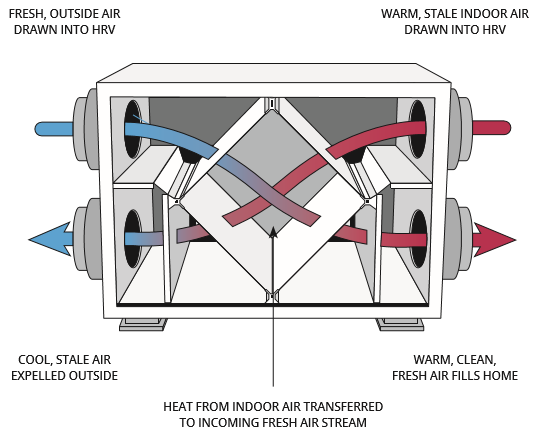The All-Inclusive Overview to the Uses of Heat Recovery Ventilation in Modern Structures
Heat Recovery Ventilation (HRV) systems stand for a considerable advancement in building technology (HRV Heat Recovery Ventilation). They supply a method for exchanging stale indoor air with fresh outside air while reducing power loss. This technique not just enhances interior air high quality but also adds to energy efficiency in both household and industrial buildings. Recognizing the numerous applications and benefits of HRV can reveal its important duty in modern style and sustainability initiatives. The ramifications of this technology deserve discovering even more
Comprehending Heat Recovery Ventilation Solutions

Lots of modern-day structures prioritize power performance, recognizing warm healing ventilation (HRV) systems is crucial for optimizing indoor air high quality and reducing power consumption. HRV systems function by transferring warm from stagnant indoor air to incoming fresh air, properly keeping comfy interior temperature levels while decreasing power loss. These systems include a warm exchanger, followers, and ductwork that assist in the circulation of air. During winter months, HRV systems capture and reuse warm from the outbound air, while in summer season, they can help cool inbound air. By continually trading air, HRV systems additionally minimize humidity and the focus of indoor contaminants. Correct installment and upkeep of HRV systems are important for their effectiveness and efficiency in boosting overall structure efficiency and convenience.
Benefits of Heat Recovery Ventilation
Heat recovery ventilation systems offer numerous benefits that boost both energy performance and interior air top quality in contemporary structures. By capturing and recycling energy from exhaust air, these systems greatly minimize heating & cooling prices, resulting in lower energy intake. They maintain a constant flow of fresh outdoor air, lessening the risk of indoor air pollutants and irritants. This continuous exchange helps manage humidity levels, preventing mold and mildew development and making certain a healthier living atmosphere. Furthermore, HRV systems contribute to sustainability goals by lowering overall carbon impacts. Their capability to maximize air flow without giving up thermal convenience makes them a valuable enhancement to modern structure style, promoting both financial and environmental advantages.
Applications of HRV in Residential Buildings
As house owners increasingly focus on power effectiveness and interior air top quality, the applications of heat recuperation air flow (HRV) systems in household buildings have actually become extra common. HRV systems are particularly helpful in securely secured homes, where preserving fresh air circulation is essential for stopping wetness buildup and indoor toxins. They successfully transfer warm from outward bound stagnant air to incoming fresh air, decreasing power expenses associated with cooling and heating. Furthermore, check it out HRVs can enhance convenience degrees by regulating moisture and temperature level. They are additionally versatile for different domestic layouts, consisting of single-family homes and multi-unit structures. In general, integrating HRV systems supports sustainable living methods while guaranteeing a healthier interior setting for occupants.
HRV in Industrial and Industrial Settings
In commercial and industrial setups, the application of warmth recuperation air flow (HRV) systems has become significantly important for optimizing energy efficiency and maintaining air top quality. These systems successfully transfer heat from exhaust air to inbound fresh air, lowering the need for added home heating or cooling. This not just lowers power costs however also adds to sustainability initiatives. Industries such as manufacturing, warehousing, and office complex profit substantially from HRV systems, as they help regulate temperature and humidity levels, guaranteeing a comfy and efficient atmosphere. HRV systems aid in getting rid of impurities and excess dampness, enhancing indoor air quality. As laws around air high quality end up being more stringent, the adoption of HRV innovation is most likely to grow, making it a crucial element of modern business and industrial facilities.
Future Fads in Heat Recovery Ventilation Technology

Often Asked Concerns
Exactly How Does Heat Recovery Ventilation Effect Indoor Air Top Quality?
Heat recovery ventilation greatly improves interior air top quality by constantly exchanging stagnant indoor air with fresh outside air while recuperating energy. This process lowers toxins, maintains optimal humidity levels, and ensures a healthier atmosphere for passengers.
Can HRV Systems Be Installed in Existing Structures?
HRV systems can undoubtedly be mounted in existing structures. Retrofitting may need adjustments to ductwork and ventilation designs, but it substantially enhances energy performance and indoor air quality, making it a sensible choice for older structures.
What Maintenance Is Needed for HRV Solutions?

Are There Particular Climates Where HRV Is Much More Efficient?
Heat recovery ventilation systems are particularly efficient in climates with significant temperature level distinctions in between seasons. These systems maximize energy performance by recuperating heat from exhaust air, making them excellent for both cool and reasonably warm settings.
Exactly How Do HRV Systems Affect Energy Expenses?
